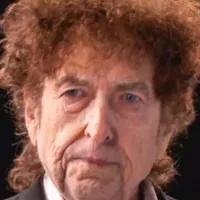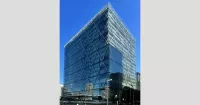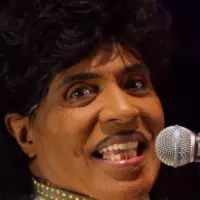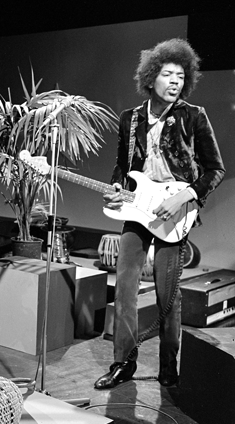Jimi Hendrix was an American musician renowned for his extraordinary skills as a guitarist, songwriter, and singer. Despite a brief mainstream career lasting only four years, he achieved legendary status as one of the most exceptional and influential electric guitarists in popular music history. His impact on music remains significant, solidifying his place as a celebrated 20th-century musician. The Rock and Roll Hall of Fame recognizes his unparalleled talent, deeming him "arguably the greatest instrumentalist in the history of rock music."
June 10, 1919: Birth of James Allen Hendrix
James Allen Hendrix, Jimi Hendrix's father, was born on June 10, 1919, in Vancouver, Canada. He was raised by his parents, Bertran Philander Ross Hendrix and Zenora "Nora" Rose Moore.
1925: Not applicable
Not applicable
1941: Al Hendrix and Lucille Jeter Meet
Al Hendrix and Lucille Jeter's paths crossed in 1941 when they met at a dance. This encounter marked the beginning of their relationship, which would lead to the birth of their son, Jimi Hendrix.
March 31, 1942: Marriage of Al Hendrix and Lucille Jeter
Al Hendrix and Lucille Jeter, Jimi Hendrix's parents, were married on March 31, 1942, in Seattle, Washington.
November 27, 1942: Birth of Jimi Hendrix
On November 27, 1942, Jimi Hendrix was born Johnny Allen Hendrix in Seattle, Washington.
September 1, 1945: Al Hendrix's Discharge from the Army
Al Hendrix received an honorable discharge from the US Army on September 1, 1945, after serving in World War II. His return marked the beginning of his reunion with Lucille and their son, Jimi Hendrix.
1946: Jimi Hendrix's Name Change
In 1946, Jimi Hendrix's parents made the decision to change his name from Johnny Allen Hendrix to James Marshall Hendrix, in honor of Al Hendrix and his late brother, Leon Marshall.
1948: Birth of Leon Hendrix
Leon Hendrix, Jimi Hendrix's younger brother, was born in 1948.
1949: Birth of Joseph Hendrix
Joseph Hendrix, Jimi Hendrix's younger brother, was born in 1949.
1950: Birth of Kathy Hendrix
Kathy Hendrix, Jimi Hendrix's younger sister, was born in 1950.
December 17, 1951: Divorce of Al Hendrix and Lucille Jeter
After a tumultuous period marked by poverty, alcohol abuse, and domestic violence, Al Hendrix and Lucille Jeter divorced on December 17, 1951. The court granted Al custody of Jimi and his brother Leon.
1957: Hendrix Receives His First Ukulele
At 15 years old, Jimi Hendrix's musical journey began when he acquired his first instrument, a ukulele, in 1957. This simple instrument sparked a passion within him that would shape his destiny.
February 2, 1958: Death of Lucille Hendrix
Tragically, at the age of 33, Lucille Hendrix, Jimi Hendrix's mother, passed away on February 2, 1958, due to cirrhosis of the liver.
1958: Hendrix Gets His First Acoustic Guitar
In 1958, at the age of 15, Jimi Hendrix got his first acoustic guitar. This marked a pivotal moment in his life, as he would go on to become one of the most celebrated guitarists in history.
1958: Not applicable
Not applicable
1959: Hendrix Meets Billy Davis
In 1959, Jimi Hendrix met guitarist Billy Davis, a member of Hank Ballard & The Midnighters. Davis became a mentor to Hendrix, teaching him guitar licks and helping him secure a gig with the Midnighters.
1959: Early Musical Explorations
In 1959, a young Jimi Hendrix formed his first band, the Velvetones, after getting an acoustic guitar. Realizing the limitations of the instrument, he switched to an electric guitar, a white Supro Ozark, bought by his father. His first gig was at Seattle's Temple De Hirsch, but he was fired for his flamboyant style. He then joined the Rocking Kings, playing at venues like the Birdland club. After an incident where his guitar was stolen, he started using a red Silvertone Danelectro.
May 31, 1961: Enlistment and Musical Beginnings in the Army
On May 31, 1961, facing legal trouble, Jimi Hendrix chose to enlist in the Army rather than face imprisonment. After basic training, he was stationed at Fort Campbell, Kentucky. His passion for music remained, and he wrote to his father requesting his red Silvertone Danelectro guitar.
November 1961: Musical Collaboration and Challenges in the Army
In November 1961 at Fort Campbell, Hendrix's musical talent caught the attention of fellow serviceman Billy Cox. Impressed by his unique style, Cox and Hendrix started jamming together. They formed a band called the Casuals and performed at base clubs. However, Hendrix's dedication to music led to neglect of his duties, resulting in reprimands and conflicts with his peers.
1961: Hendrix Enlists in the US Army
At 19 years old, Jimi Hendrix made the decision to enlist in the US Army in 1961. This experience exposed him to a new level of discipline and structure but ultimately proved to be short-lived.
January 11, 1962: Achieving Screaming Eagles Status
On January 11, 1962, despite his challenges in the Army, Jimi Hendrix's talent and perseverance in training earned him the prestigious Screaming Eagles patch, a testament to his physical and mental strength.
June 29, 1962: Discharge from the Army
Jimi Hendrix's military career came to an end on June 29, 1962, when he received a general discharge under honorable conditions. His time in the Army, though marked by some difficulties, played a pivotal role in shaping his character and musical journey.
July 1962: Visit to Jazz Club in Clarksville
In July 1962, Hendrix spent most of the $400 he had saved during his time in the Army during a visit to a jazz club in Clarksville, Tennessee. This event marked the beginning of Hendrix's complex relationship with alcohol.
September 1962: Forming the King Kasuals and Developing Showmanship
After his discharge, Hendrix and Billy Cox moved to Clarksville, Tennessee, forming a band called the King Kasuals. It was during this time that Hendrix, inspired by another guitarist, began incorporating playing with his teeth into his performances, a technique that would become one of his signature moves.
January 1964: Striking Out Solo and Finding Support in Harlem
Seeking new creative opportunities, Hendrix decided to pursue a solo career in January 1964, moving to Harlem, New York City. There he met Lithofayne Pridgon, known as "Faye", who became a significant source of support and introduced him to the vibrant Harlem music scene. He also connected with the influential Allen twins, Arthur and Albert, further expanding his network.
February 1964: Apollo Theater Triumph and Joining the Isley Brothers
Hendrix's talent shone brightly in February 1964 when he won first prize in the Apollo Theater amateur contest. This victory opened doors, leading to gigs in Harlem clubs. An audition with Ronnie Isley resulted in Hendrix joining the Isley Brothers' backing band, the I.B. Specials, marking a significant step forward in his career.
March 1964: Recording with the Isley Brothers
In March 1964, Hendrix took a significant step in his recording career by contributing to the Isley Brothers' two-part single "Testify". Although the single, released in June, did not achieve chart success, it provided valuable experience and exposure for the rising guitarist.
1964: Creation of Hendrix's First Stratocaster
The Fender Stratocaster that would become synonymous with Hendrix was built in 1964.
1964: Touring and Expanding Horizons
Throughout 1964, Hendrix toured extensively with the Isley Brothers, gaining invaluable experience and honing his skills. This period marked a significant phase of musical growth and development as he adapted to the demands of the road and performing for diverse audiences.
February 1965: Working with Little Richard and Rosa Lee Brooks
In February 1965, during a stop in Los Angeles with Little Richard's band, Hendrix recorded his first and only single with Richard, "I Don't Know What You Got (But It's Got Me)". He also met singer Rosa Lee Brooks, contributing guitar to her single and forming a lasting friendship.
July 1965: Television Debut and Departure from Little Richard
July 1965 marked Hendrix's first television appearance on Nashville's Channel 5 Night Train, backing Buddy and Stacy on "Shotgun" as part of Little Richard's band. This appearance is the earliest known footage of his performance. Clashes with Richard over various issues led to Hendrix's dismissal from the band later that month.
October 1965: New Contract and Continued Session Work
In October 1965, Hendrix signed a recording contract with Ed Chalpin, a decision that would later lead to legal complications. He continued to work as a session musician, notably with King Curtis, and even toured briefly with Joey Dee and the Starliters.
1965: Hendrix Joins Little Richard's Band
A pivotal moment in Jimi Hendrix's career occurred in 1965 when he joined Little Richard's band. This opportunity allowed him to further hone his skills as a guitarist and gain valuable experience performing in a high-profile setting.
1965: Early Amplifier Use
Hendrix mainly relies on a Fender Twin Reverb amplifier for his performances with soul and R&B acts.
1965: Signing Recording Contract with PPX
Hendrix signs a recording contract with PPX in 1965, a decision that would later lead to the unauthorized release of his early recordings.
May 1966: Hendrix Meets Linda Keith
In May 1966, struggling to earn a living wage playing the R&B circuit, Hendrix briefly rejoined Curtis Knight and the Squires for an engagement at the Cheetah Club in New York City. During a performance, Linda Keith, the girlfriend of Rolling Stones guitarist Keith Richards, noticed Hendrix and was mesmerized by his playing. She invited him for a drink, and the two became friends.
September 24, 1966: Hendrix Signed by Chas Chandler
On September 24, 1966, Chas Chandler, former member of the Animals, saw Jimi Hendrix play at Cafe Wha? in New York City and was impressed. He brought Hendrix to London, signed him to a management and production contract, and that night, Hendrix gave an impromptu solo performance at The Scotch of St James. He also began a relationship with Kathy Etchingham that lasted for two and a half years.
October 1, 1966: Hendrix Meets Eric Clapton
On October 1, 1966, Chas Chandler brought Hendrix to the London Polytechnic at Regent Street, where Cream was scheduled to perform. Hendrix met guitarist Eric Clapton and was invited to play a couple of numbers. Halfway through Cream's set, Hendrix performed a frantic version of 'Killing Floor,' leaving a lasting impression on Clapton, who later described the performance as life-changing.
October 11, 1966: Hendrix Purchases Marshall Equipment
Hendrix purchases a collection of Marshall amplifiers and speaker cabinets, solidifying his preference for the brand.
October 13, 1966: First Show of The Jimi Hendrix Experience
On October 13, 1966, The Jimi Hendrix Experience performed their first show as Johnny Hallyday's supporting act at the Novelty in Evreux, France. The performance was enthusiastically received, marking the beginning of the band's live performances.
October 1966: Experience's Early Success and Recordings
In October 1966, The Jimi Hendrix Experience performed in Paris, with their performance at the Olympia theatre marking the earliest known recording of the band. Later that month, they signed with Track Records and recorded their first song, 'Hey Joe' on October 23. Hendrix's first songwriting effort in England, 'Stone Free,' was recorded on November 2.
October 1966: Introduction to Marshall Amps
Upon arriving in England, Hendrix is introduced to Marshall amplifiers.
December 1966: Introduction to the Octavia Pedal
In December 1966, Jimi Hendrix was introduced to the Octavia, an octave-doubling effect pedal, by electronics enthusiast Roger Mayer. Hendrix first recorded with it during the guitar solo of "Purple Haze," marking a significant innovation in his sound.
December 16, 1966: Release of 'Hey Joe'
On December 16, 1966, The Jimi Hendrix Experience released their first single, 'Hey Joe,' backed with 'Stone Free,' through a distribution deal with Polydor Records. The single's success marked the beginning of Hendrix's rise in the UK music scene.
1966: First Composer Credits
Hendrix achieved a milestone in 1966 when two of his instrumental compositions, "Hornets Nest" and "Knock Yourself Out", were released as a single by Curtis Knight and the Squires. This marked the beginning of his recognition as a songwriter.
1966: Hendrix Acquires his First Stratocaster
Hendrix acquires his first Fender Stratocaster, a used model, marking the beginning of his long association with the instrument.
1966: Introduction to Psychedelics
In 1966, Hendrix was introduced to psychedelics at Linda Keith's New York apartment, showing his naivete and inexperience with such substances at the time.
1966: Legal Disputes and the Formation of Band of Gypsys
In 1966, a legal dispute arose from a past record contract. To resolve it, Hendrix formed Band of Gypsys, an all-black power trio, and recorded their live performances for an album, showcasing a unique blend of rock, funk, and soul influences.
1966: First Guitar-Smashing Incident
In 1966, during a short residency at the Big Apple club in Munich, Hendrix had a show experience that would define him: he smashed his guitar for the first time on stage. This act, perceived by the audience as part of the show, led manager Chas Chandler to decide that it should become a permanent feature of The Experience's performances.
1966: Hendrix Moves to New York and Forms Band
In 1966, feeling restricted by his experiences as an R&B sideman, Jimi Hendrix moved to New York City's Greenwich Village. There, he formed his own band, Jimmy James and the Blue Flames, and began developing his guitar style and material that he would soon use with the Experience. By September, the band gave some of their last concerts at the Cafe Au Go Go in Manhattan.
1966: Moving to England and Forming the Jimi Hendrix Experience
Under the guidance of his new manager, Chas Chandler, Jimi Hendrix made the life-altering decision to move to England in 1966. It was there that he formed his legendary band, The Jimi Hendrix Experience, which would go on to achieve phenomenal success.
March 12, 1967: Performance Stopped by Police
On March 12, 1967, Jimi Hendrix performed at the Troutbeck Hotel, Ilkley, West Yorkshire. The gig was stopped by local police due to safety concerns after about 900 people turned up at a venue licensed for only 250.
March 1967: Success of 'Purple Haze'
In March 1967, Jimi Hendrix's single 'Purple Haze' became a hit in the UK, peaking at number three on the charts. This success further established Hendrix as a significant figure in the music industry.
March 31, 1967: Hendrix Sets Guitar on Fire
On March 31, 1967, Jimi Hendrix set his guitar on fire during a performance at the London Astoria, following advice to do something dramatic for media exposure. The stunt earned him titles like 'Black Elvis' and 'Wild Man of Borneo' from the press.
May 1, 1967: "Hey Joe" Release and McCartney's Advocacy
Despite gaining popularity in Europe, The Jimi Hendrix Experience's first U.S. single, "Hey Joe," failed to chart on the Billboard Hot 100 following its release on May 1, 1967. However, their trajectory shifted when Paul McCartney recognized their talent and championed their inclusion in the Monterey Pop Festival. McCartney's insistence stemmed from his belief that the festival would be incomplete without Hendrix, whom he considered "an absolute ace on the guitar." This advocacy proved pivotal in securing The Jimi Hendrix Experience's performance slot at the festival in mid-June.
May 12, 1967: Release of 'Are You Experienced' in the UK
Released in the UK on May 12, 1967, 'Are You Experienced' spent 33 weeks on the charts, peaking at number two, just behind The Beatles' 'Sgt. Pepper's Lonely Hearts Club Band.'
May 1967: Hendrix Discovers Wah-Wah Pedal
In May 1967, Jimi Hendrix first heard the wah-wah pedal used with an electric guitar in Cream's "Tales of Brave Ulysses." This inspired him to experiment with the effect, which became a signature element of his sound.
June 4, 1967: Hendrix's Tribute to The Beatles
On June 4, 1967, Jimi Hendrix opened a show at the Saville Theatre in London with his rendition of The Beatles' 'Sgt. Pepper's Lonely Hearts Club Band' title track. The performance was attended by Beatles members George Harrison and Paul McCartney, who described it as a major compliment.
June 1967: First Use of LSD
In June 1967, Hendrix first used LSD while attending the Monterey Pop Festival. This marked the beginning of his regular use of various drugs.
June 18, 1967: Monterey Pop Festival Performance
On June 18, 1967, at the Monterey Pop Festival, The Jimi Hendrix Experience delivered a groundbreaking performance. Introduced by Brian Jones as "the most exciting performer [he had] ever heard," Hendrix captivated the audience with his unique style and musical prowess.
August 1967: "Burning of the Midnight Lamp" UK Single Release
August 1967 saw the release of "Burning of the Midnight Lamp" as a single in the UK. Notably, it was Hendrix's first recorded track to incorporate the wah-wah pedal, a sonic innovation that would become one of his signature effects.
December 1, 1967: Axis: Bold as Love UK Release
The Jimi Hendrix Experience's second studio album, "Axis: Bold as Love," hit the UK music scene on December 1, 1967. The album's psychedelic cover art, featuring Hendrix and the band as avatars of Vishnu, added to its mystique.
December 20, 1967: Electric Ladyland Recording Begins
The creative journey of The Jimi Hendrix Experience's third and final studio album, "Electric Ladyland," commenced on December 20, 1967, at Olympic Studios.
1967: Unauthorized Release of Early Recordings
As Hendrix's fame grew in 1967, unauthorized recordings from his time with PPX were released, much to his disapproval. He criticized the quality of these recordings.
1967: Iconic Photo of Burning Guitar
During The Jimi Hendrix Experience's performance at the 1967 Monterey Pop Festival, 17-year-old Ed Caraeff captured one of rock and roll's most enduring images. As Hendrix set his guitar ablaze, Caraeff, in the front row, used the last frame on his roll of film to document the moment.
1967: Hendrix Praises the Stratocaster
Hendrix expresses his admiration for the Fender Stratocaster, praising its versatility and tonal qualities.
1967: Release of Iconic Albums
In 1967, Jimi Hendrix released his first two studio albums, 'Are You Experienced' and 'Axis: Bold as Love,' both of which were later ranked among the 500 Greatest Albums of All Time by Rolling Stone magazine.
1967: Melody Maker's Pop Musician of the Year
In 1967, Jimi Hendrix was voted Pop Musician of the Year by readers of Melody Maker magazine. This award signified his rising popularity and the impact he was making on the music scene.
1967: Pop Musician of the Year
In 1967, Jimi Hendrix was voted the Pop Musician of the Year by readers of Melody Maker, marking a significant recognition in his career.
1967: Breakthrough Performance at Monterey Pop Festival
Jimi Hendrix's performance at the Monterey Pop Festival in 1967 catapulted him to fame in the United States. His innovative guitar playing and captivating stage presence left an unforgettable mark on the audience and solidified his status as a rising star.
February 1968: Axis: Bold as Love US Release
Following its UK debut, "Axis: Bold as Love" made its way to American audiences in February 1968, further solidifying The Jimi Hendrix Experience's growing international acclaim.
April 1968: Electric Ladyland Recording Moves to Record Plant Studios
In April 1968, The Jimi Hendrix Experience shifted their recording base for "Electric Ladyland" to the newly established Record Plant Studios in New York. This move marked a change in environment and production approach.
1968: Purchase of Generation Club
In 1968, Hendrix and Jeffery invested in the Generation Club in Greenwich Village. They decided to convert it into a recording studio to reduce Hendrix's recording expenditures, leading to the creation of Electric Lady Studios.
1968: Writing Songs for Next Album
In 1968, Hendrix began writing songs for what would have been his next LP. However, by April 1970, he had abandoned the project.
1968: Electric Ladyland Release
In 1968, Jimi Hendrix released his third studio album, 'Electric Ladyland,' which was also ranked among the 500 Greatest Albums of All Time by Rolling Stone magazine.
1968: Hendrix's Early Influences
In 1968, Jimi Hendrix told Guitar Player magazine about his early influences, mentioning rock and roll artists like Elvis Presley, Little Richard, and Chuck Berry, as well as electric blues artists Muddy Waters, Elmore James, and B. B. King.
1968: Performer of the Year and Keys to Seattle
In 1968, Jimi Hendrix was declared the Performer of the Year by Rolling Stone and was also given the keys to the city of Seattle, highlighting his growing influence and recognition.
1968: Release of "Electric Ladyland"
Jimi Hendrix achieved a major milestone in 1968 with the release of his third and final studio album, "Electric Ladyland." This double LP became his most commercially successful release, reaching the coveted number one spot on the charts.
1968: Billboard Artist of the Year and Rolling Stone Performer of the Year
Jimi Hendrix's exceptional talent was recognized by prominent music publications in 1968. Billboard named him Artist of the Year, while Rolling Stone declared him Performer of the Year, highlighting his significant contributions to the industry.
January 1969: Hendrix Returns to London and Appears on BBC
In January 1969, Hendrix briefly moved back to his girlfriend's apartment in London. He also appeared on BBC's Happening for Lulu, performing "Voodoo Child" and an extended version of "Sunshine of Your Love", which led to a memorable on-stage moment and, according to legend, Hendrix being banned from the BBC.
February 1969: Tensions Rise and Redding Leaves the Experience
By February 1969, growing tensions within the Experience, particularly between Hendrix and bassist Noel Redding, came to a head. Redding was frustrated with Hendrix's work ethic and creative control, ultimately leading to his departure from the band after a final recording session in April.
May 3, 1969: Drug Possession Arrest in Toronto
Hendrix was arrested at Toronto International Airport on May 3, 1969, for possession of heroin and hashish.
June 29, 1969: The Last Performance of the Original Experience
On June 29, 1969, the original Experience lineup played their final show at the Denver Pop Festival. The event was marked by chaos, with the band escaping in a truck mobbed by fans. Redding officially quit the next day, citing Hendrix's plans to expand the group without his input.
September 1969: Performance on "The Dick Cavett Show"
Hendrix uses a white Gibson SG Custom during his appearance on "The Dick Cavett Show" in September 1969.
December 1969: Acquittal in Drug Possession Trial
In December 1969, Hendrix stood trial for drug possession charges stemming from his May arrest in Toronto. He was acquitted after claiming he didn't know the drugs were planted in his bag.
1969: Hendrix Retreats and Makes US Television Appearances
Following Redding's departure, Hendrix stayed at the Ashokan House in New York. During this time, he made notable appearances on American television, including The Dick Cavett Show and The Tonight Show, without Mitch Mitchell but accompanied by other musicians.
1969: World Top Musician of 1969
In 1969, Disc & Music Echo newspaper honored Jimi Hendrix as the World Top Musician of the year, further cementing his status as a leading figure in rock music.
1969: Hendrix Headlines Woodstock and Becomes Highest-Paid Musician
In 1969, Hendrix achieved a career-high by becoming the world's highest-paid rock musician. He headlined the Woodstock Music and Art Fair, a landmark event where he performed with a new lineup, despite his discomfort with large crowds.
1969: Incidents of Violence and Substance Abuse
In 1969, Hendrix exhibited erratic behavior fueled by drugs and alcohol. He falsely accused a friend of theft, assaulted him, and later injured his girlfriend during a jealous rage.
1969: Headlining Woodstock
In 1969, Jimi Hendrix's career reached new heights when he headlined the iconic Woodstock Festival. His performance at Woodstock became legendary, showcasing his extraordinary talent and solidifying his place in music history.
1969: World Top Musician by Disc and Music Echo
Jimi Hendrix's global impact was acknowledged in 1969 when Disc and Music Echo honored him with the prestigious title of World Top Musician.
January 28, 1970: Final Performance of Band of Gypsys
On January 28, 1970, the Band of Gypsys gave their final performance at Madison Square Garden during the 'Winter Festival for Peace'. Hendrix appeared distressed, and after a brief and troubled performance, he left the stage. It was later revealed that Jeffery had given Hendrix LSD before the show, allegedly to sabotage the band and bring back the original Experience lineup.
February 1970: Reunion of the Original Experience
In February 1970, Jeffery arranged for the original Experience lineup to reunite. Although Hendrix, Mitchell, and Redding were interviewed as a united group, Hendrix never intended to work with Redding again. Redding was replaced by Cox, and despite the lack of an official name, promoters often billed them as the Jimi Hendrix Experience or just Jimi Hendrix.
April 1970: Release of Band of Gypsys Album
In April 1970, Capitol Records released the Band of Gypsys album, which was the only official live Hendrix LP available during his lifetime. It reached the top ten in both the US and the UK. During the same month, a single with 'Stepping Stone' as the A-side and 'Izabella' as the B-side was issued, but Hendrix was unhappy with the mastering quality and demanded it be withdrawn and re-mixed, leading to its poor chart performance.
April 1970: Cry of Love Tour Kickoff
In April 1970, Hendrix and his band took a break from recording and began the Cry of Love tour at the L.A. Forum, performing for 20,000 people. This tour included numerous Experience tracks and newer material.
June 15, 1970: First Use of Electric Lady Studios
On June 15, 1970, Hendrix first used Electric Lady Studios, jamming with Steve Winwood and Chris Wood of Traffic.
July 1970: Second Atlanta International Pop Festival
In July 1970, Jimi Hendrix played to the largest American audience of his career at the Second Atlanta International Pop Festival near Byron, Georgia.
August 1, 1970: Final US Concert Appearance
On August 1, 1970, Hendrix performed his final concert in the US at the Honolulu, Hawaii, ending the American leg of the Cry of Love tour. This concert marked the end of a series of 32 performances.
August 31, 1970: Performance at Isle of Wight Festival
On August 31, 1970, Hendrix performed as the headlining act at the Isle of Wight Festival in England, his last major performance before leaving for England.
September 2, 1970: Abandoned Performance in Aarhus
On September 2, 1970, Hendrix abandoned a performance in Aarhus after three songs, stating: 'I've been dead a long time'. This was part of the European leg of the Cry of Love tour.
September 1970: Jimi Hendrix's Passing
In September 1970, at the young age of 27, Jimi Hendrix died in London from barbiturate-related asphyxia. His passing marked a significant loss for the music world.
September 17, 1970: Hendrix's Final Hours
Hendrix spent his last day, September 17, 1970, in London with Monika Dannemann. Accounts detail their activities, including meals, outings, and returning to Dannemann's flat in the early morning hours.
September 18, 1970: Death of Jimi Hendrix
Jimi Hendrix tragically passed away on September 18, 1970, in London, England. His death was ruled as barbiturate-related asphyxia.
1970: Performance at the Isle of Wight Festival
Hendrix plays a black Gibson Flying V at the Isle of Wight Festival in 1970.
1970: Hendrix's Iconic "Star-Spangled Banner" Performance at Woodstock
Hendrix's rendition of "The Star-Spangled Banner" at Woodstock, filled with feedback and distortion, became an iconic moment of the sixties. Interpreted by many as an anti-war statement, it solidified his performance as legendary.
1970: Rock Guitarist of the Year
In 1970, Guitar Player magazine named Jimi Hendrix as the Rock Guitarist of the Year, acknowledging his exceptional talent and contributions to music.
1970: Hendrix on Muddy Waters and Bob Wills
In 1970, Jimi Hendrix told Rolling Stone that he was a fan of the electric blues artist Muddy Waters and western swing artist Bob Wills. He recalled being scared by Waters' early records as a child and mentioned watching the Grand Ole Opry while living in Nashville.
1970: Guitar Player's Rock Guitarist of the Year
In 1970, Jimi Hendrix was posthumously named Rock Guitarist of the Year by Guitar Player magazine. This recognition further solidified his legacy as one of the greatest guitarists of all time.
1970: Not applicable
Not applicable
1971: Posthumous Release: "The Cry of Love"
"The Cry of Love," a compilation of Hendrix's unfinished material, was released in 1971, reaching high chart positions in the US and UK.
1972: Posthumous Release: "War Heroes"
Another collection of Hendrix's unreleased songs, "War Heroes," was issued in 1972, continuing the posthumous exploration of his music.
1974: Sale of Distribution Rights
Al Hendrix sells distribution rights to Hendrix's music to a foreign corporation, a decision that would later become a point of contention.
1987: Rolling Stone Cover and Recognition
Ed Caraeff's iconic image of Jimi Hendrix burning his guitar at the 1967 Monterey Pop Festival gained further prominence in 1987 when Rolling Stone featured a colorized version of the photograph on its magazine cover.
1989: Clapton Recalls Hendrix's Performance
In 1989, Eric Clapton described Jimi Hendrix's 1966 performance at the London Polytechnic. Clapton noted that Hendrix played various styles, including tricks like playing with his teeth and behind his back, leaving a profound impact on him. Clapton said his life was never the same again after that performance.
1989: Guitar World Recognition
In 1989, Guitar World's founding editor, Noe Goldwasser, hailed Jimi Hendrix's "Are You Experienced" album as groundbreaking, stating that it "shook the world... leaving it forever changed."
1989: Electric Ladyland: Hendrix's Masterpiece
Noe Goldwasser, a prominent voice in the guitar world, lauded "Electric Ladyland" as Jimi Hendrix's seminal work in 1989, recognizing its artistic depth and impact.
November 14, 1991: Hollywood Walk of Fame Star
On November 14, 1991, Jimi Hendrix was honored with a star on the Hollywood Walk of Fame, located at 6627 Hollywood Boulevard. This recognition highlighted his lasting impact on music and culture.
November 27, 1992: Jimi Hendrix Day in Seattle
On November 27, 1992, which would have been Hendrix's 50th birthday, Seattle declared the day as Jimi Hendrix Day, largely due to the efforts of his boyhood friend, guitarist Sammy Drain.
1992: Lifetime Achievement Grammy Award
In 1992, Jimi Hendrix received a Lifetime Achievement Award from the Grammy Awards, recognizing his enduring impact on music.
1992: Induction into the Rock and Roll Hall of Fame
The Jimi Hendrix Experience received one of the highest honors in the music industry in 1992 when they were inducted into the Rock and Roll Hall of Fame. This induction cemented their place as one of the most influential and important bands in rock history.
1993: Dispute over Publishing Copyrights
Al Hendrix halts the sale of Hendrix's publishing copyrights by MCA Records, expressing dissatisfaction with the proposed arrangement.
July 1995: Settlement and Regaining Control
Al Hendrix reaches a settlement in July 1995, securing control over his son's musical legacy and image rights.
1997: Posthumous Release: "First Rays of the New Rising Sun"
The album "First Rays of the New Rising Sun" was released in 1997, aiming to present Hendrix's unfinished work as he envisioned it, including tracks intended for "The Cry of Love."
1998: Native American Music Hall of Fame Induction
In 1998, Jimi Hendrix was inducted into the Native American Music Hall of Fame during its first year, recognizing his contributions and heritage.
1999: Grammy Awards for Albums
In 1999, Jimi Hendrix received two Grammy Awards for his albums 'Are You Experienced' and 'Electric Ladyland,' acknowledging their lasting significance.
1999: Ranked Among Most Important Musicians
In 1999, readers of Rolling Stone and Guitar World ranked Jimi Hendrix among the most important musicians of the 20th century, affirming his influential legacy.
2000: Hall of Fame Grammy for Purple Haze
In 2000, Jimi Hendrix received a Hall of Fame Grammy Award for his original composition, 'Purple Haze,' acknowledging its cultural impact.
2001: Hall of Fame Grammy for All Along the Watchtower
In 2001, Jimi Hendrix received a Hall of Fame Grammy Award for his recording of Bob Dylan's 'All Along the Watchtower,' recognizing its significance.
2001: Handel House Museum
In 2001, the former residence of George Frideric Handel at 25 Brook Street, London, opened to the public as the Handel House Museum, located next to Jimi Hendrix's former residence at 23 Brook Street.
2004: Electric Ladyland's Enduring Legacy
Music author Peter Doggett emphasized the enduring legacy of "Electric Ladyland" in 2004, highlighting its experimental nature, melodic richness, and instrumental brilliance, solidifying its place among rock's greatest albums.
2005: National Recording Registry Induction
In 2005, Jimi Hendrix's debut album, 'Are You Experienced,' was added to the US National Recording Registry in the Library of Congress to be preserved as part of the nation's audio legacy.
2005: Induction into the UK Music Hall of Fame
In 2005, The Jimi Hendrix Experience's impact on the British music scene was recognized with their induction into the UK Music Hall of Fame.
2005: Rolling Stone Acclaim
Rolling Stone recognized the enduring impact of Jimi Hendrix's debut album in 2005, calling it an "epochal debut." They ranked it 15th on their list of the greatest albums of all time, praising its innovative sound and Hendrix's "incendiary" guitar playing.
May 2006: Jimi Hendrix Park
In May 2006, the city of Seattle renamed a park near its Central District as Jimi Hendrix Park, in honor of the legendary guitarist.
2006: Grammy for Axis: Bold as Love
In 2006, Jimi Hendrix's album 'Axis: Bold as Love' received a Grammy Award, further recognizing his contribution to music.
August 2009: New Licensing Agreement with Sony Music Entertainment
Experience Hendrix LLC, the company managing Hendrix's estate, signs a new licensing agreement with Sony Music Entertainment's Legacy Recordings.
2009: Grammy for The Star-Spangled Banner
In 2009, Jimi Hendrix's rendition of 'The Star-Spangled Banner' was honored with a Grammy Award, celebrating his unique interpretation.
2010: Launch of Jimi Hendrix Catalog Project
Legacy Recordings commences the Jimi Hendrix Catalog Project in 2010, starting with the release of "Valleys of Neptune."
May 2012: Guitar Player Magazine Mention
In May 2012, Jimi Hendrix was mentioned in Guitar Player magazine, highlighting his lasting influence and contributions to the music world.
2012: Historic Marker for Second Atlanta International Pop Festival
In 2012, an official historic marker was erected on the site of the July 1970 Second Atlanta International Pop Festival near Byron, Georgia, commemorating Hendrix's performance there.
2014: Commemorative Postage Stamp
In 2014, the United States Postal Service issued a commemorative postage stamp honoring Jimi Hendrix, celebrating his lasting legacy.
August 21, 2016: Rhythm and Blues Music Hall of Fame Induction
On August 21, 2016, Jimi Hendrix was inducted into the Rhythm and Blues Music Hall of Fame in Dearborn, Michigan, recognizing his influence in the genre.
2016: Handel & Hendrix Museum
In 2016, the Handel House Museum was rebranded as Handel & Hendrix in London, utilizing the upper floors of 23 Brook Street for displays about Jimi Hendrix, further commemorating his life and legacy.
June 23, 2019: Band of Gypsys Induction
On June 23, 2019, the Band of Gypsys were inducted into the Rhythm and Blues Music Hall of Fame at the Charles H. Wright Museum of African American History in Detroit, Michigan. Billy Cox, the last surviving member, accepted the honor alongside representatives of the Buddy Miles and Hendrix estates.
2019: Post Office Renamed for Hendrix
In 2019, the James Marshall 'Jimi' Hendrix United States Post Office in Renton Highlands near Seattle was renamed in his honor, located about a mile from his grave and memorial.
2023: Rolling Stone Names Hendrix Greatest Guitarist of All Time
In 2023, Rolling Stone magazine bestowed upon Jimi Hendrix the title of greatest guitarist of all time. This recognition further solidified his enduring legacy and the profound impact his innovative guitar playing continues to have on musicians worldwide.
2023: Value of Hendrix's Savings Adjusted for Inflation
In 2023, the $400 Hendrix spent in 1962 was equivalent to $4,029. This adjustment highlights the significant amount he spent during his visit to the jazz club in Clarksville.
2023: Not applicable
Not applicable
Mentioned in this timeline

Bob Dylan is a highly influential American singer-songwriter renowned as...

The Billboard Hot is the primary music chart in the...

Sony is a Japanese multinational conglomerate based in Tokyo Its...

Elvis Presley the King of Rock and Roll was a...

The Woodstock Music and Art Fair held on Max Yasgur's...

Richard Wayne Penniman known as Little Richard was a highly...
Trending

1 month ago Dubai Overtakes New York as Top Destination for the World's Wealthy Elite.
1 month ago Kim Woo-bin and Shin Min-ah announce marriage after 10 years of dating.

2 months ago LoL Worlds 2025: T1 vs Gen.G Final Forecasted to Break Viewership Records

1 month ago Sadie Sink avoids Spider-Man spoilers, shows abs. Holland's mistakes provide lessons.

22 days ago Salma Hayek stuns in velvet dresses showcasing Old Hollywood glamour and Kahlua partnership.
4 months ago Uber faces scrutiny over safety record and sexual assault allegations, raising concerns.
Popular

Candace Owens is an American conservative political commentator and author...

Tucker Carlson is an American conservative political commentator known for...

XXXTentacion born Jahseh Dwayne Ricardo Onfroy was a controversial yet...

Kashyap Pramod Patel is an American lawyer who became the...

Ilhan Omar is an American politician currently serving as the...

Bill Gates an American businessman and philanthropist revolutionized personal computing...
